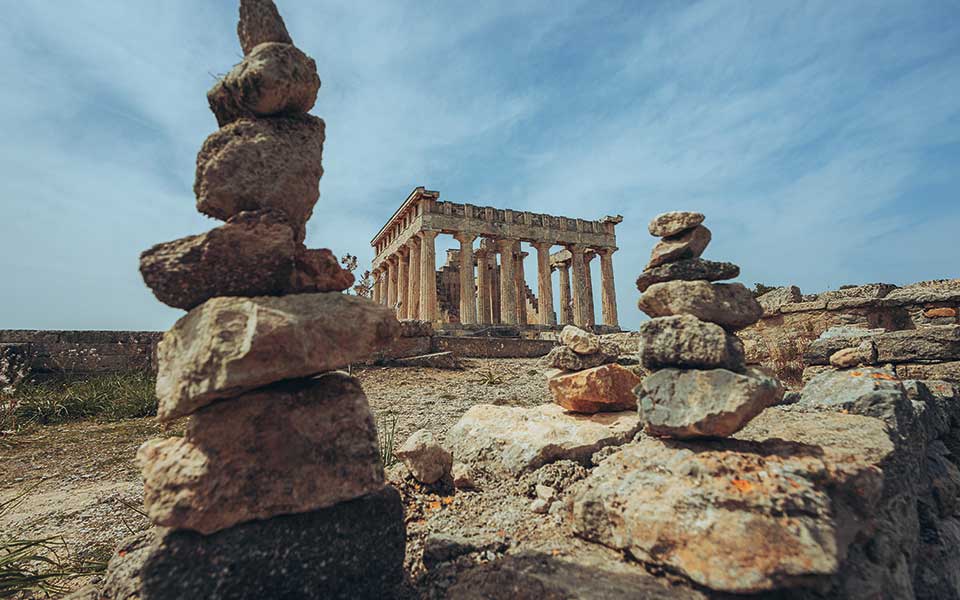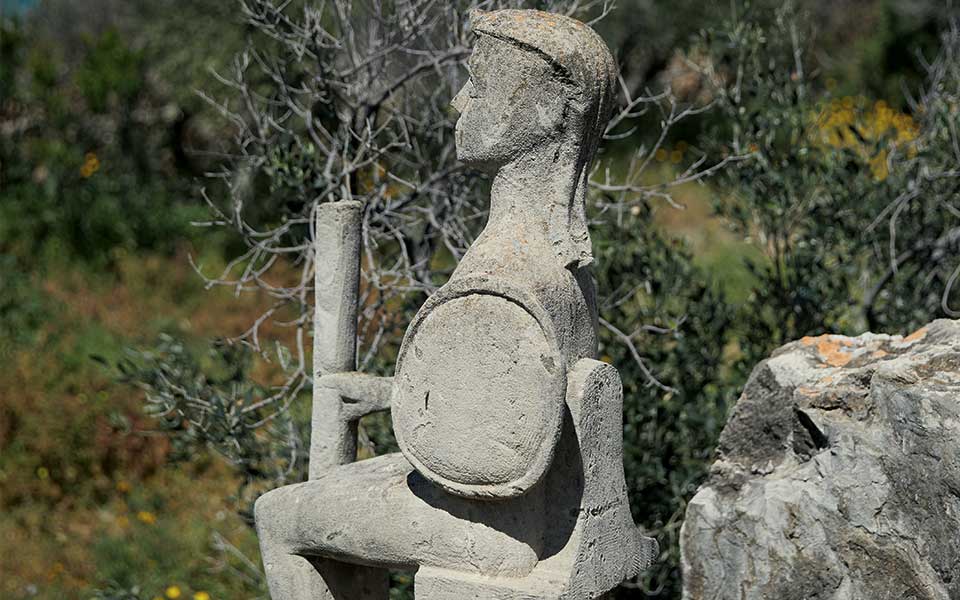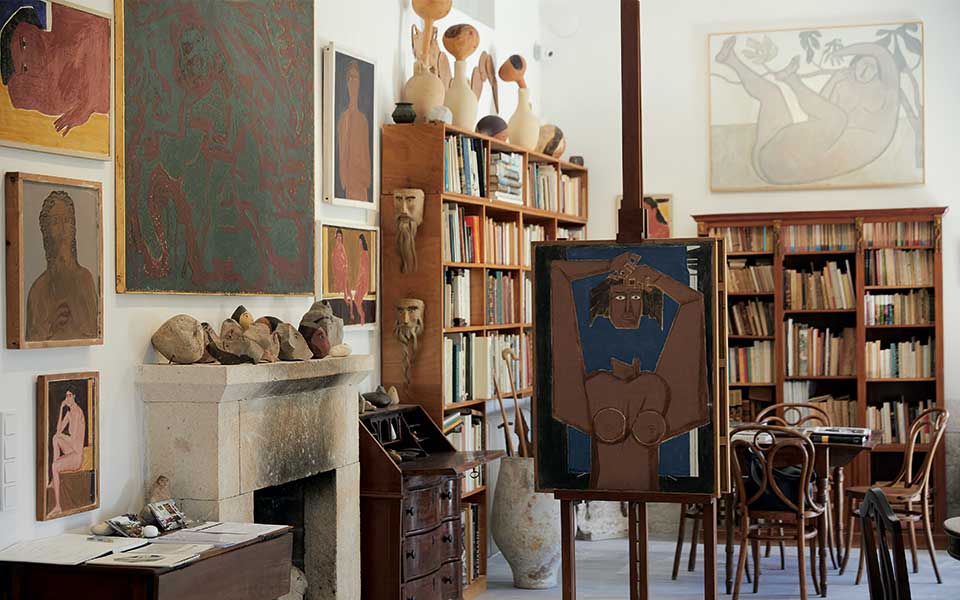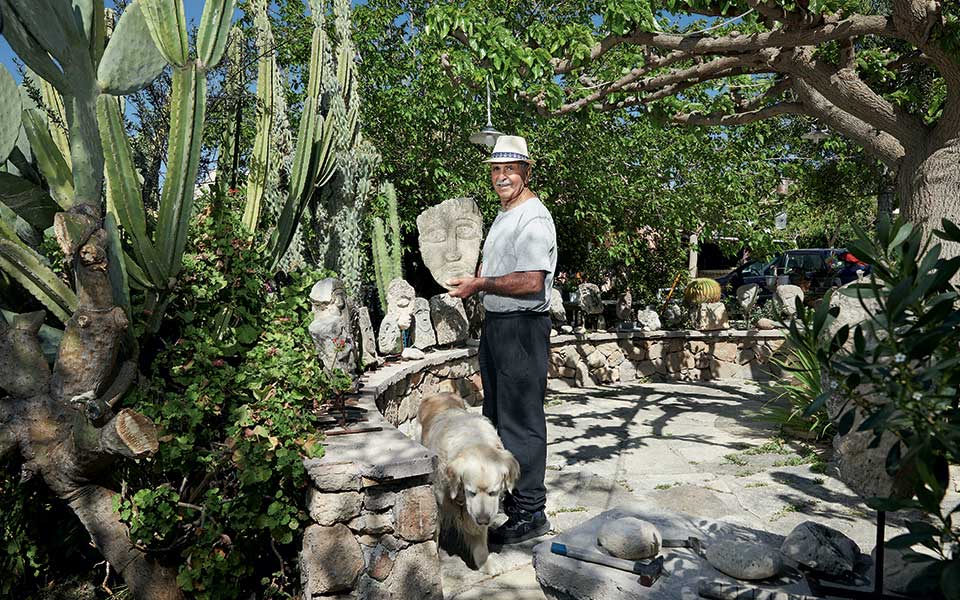5 Greek Islands that Shine in September
Discover Greece’s islands in September with...

“The Gate of Aegina” is a large-scale sculpture by artist Kostas Varotsos that welcomes visitors to the island.
© Dimitris Vlaikos
Upon arriving at the port, one is immediately welcomed into Aegina’s artistic realm by “The Gate of Aegina,” a large-scale sculpture by Kostas Varotsos. Crafted from glass and metal, it mirrors the proportions of the wooden doors found adorning the island’s neoclassical buildings. Of his piece, Varotsos, a sculptor of international note, says: “Arriving in Aegina is akin to passing through a magical gateway into paradise. Though the journey is brief, the destination feels remarkably distant.” The gate marks the start of a 45-minute art walk along the beachfront, leading to the Kapralos Museum, once the residence and workshop of the foremost Greek sculptor of the 20th century.

© Nikos Boutsikos/Nidibou Photography
As the road ascends to the left of the harbor, it leads to the archaeological site of Kolona, once a strategic vantage point crowned by the Temple of Apollo. Beyond this point, the path winds past impressive villas from the 1900s, built in line with Western architectural ideals of that era. Fifteen minutes further on is the stone house of Nikos Nikolaou, a prominent visual artist of the 1930s. His nephew, the architect Thodoris Zoumboulakis, meticulously restored the studio based on an old photograph. Inside, the presence of Nikolaou can almost be felt; his brushes, paints, and personal belongings are carefully arranged in a corner, evoking his spirit. The studio houses his vibrant paintings and the ceramic items and stones he painted, along with sculpting tools he used to shape stones that he placed into the walls.
Thodoris recounts how the stone bench outside the studio was where his uncle sat with close friends to watch the sunset and to dine together – a tradition that became legendary. A sculpture across the street, crafted by the renowned painter Yannis Moralis and donated by gallery owner Peggy Zoumboulaki, is a testament to one of Nikolaou’s significant friendships, subtly continuing the dialogue between those two artists. Just two blocks away, at 7 Yannis Moralis Street, stands the house where Moralis himself lived, designed by the architect Aris Konstantinidis. It is open to visitors each September during the Pistachio Festival.
Nikos Nikolaou used to host his extended family and circle of friends at his home in Aegina. The six guest houses have been renovated with great attention to detail. Their walls are adorned with sketches, stage designs and replicas of the artist’s paintings. In the common areas, there are objects from his personal collections as well as a number of stones on which he painted human figures.
39 Nikou Kazantzaki, Aegina, [email protected]

Τheodora Chorafa’s amorphous, cylindrical ceramic sculptures reflect the interconnected cycle of life and death.
© Dimitris Vlaikos
The tour’s next highlight is Christos Kapralos’s residence. Opposite his home and studio, a majestic statue of a female figure looms. Areti Pigiaditi, an art historian and the museum’s curator, explains that it depicts Kapralos’ mother, whom the artist cherished deeply; although she was an uneducated and impoverished woman, she supported her son’s artistic ambitions. Like many sculptures in the studio and garden, the statue references archaic sculptural forms.

Christos Kapralos' sculptures often reference archaic sculptural forms.
© Dimitris Vlaikos
A singular surprise awaits in the Mesagros region, where the home of Alexandros Rodakis is located. Rodakis was a man of simple means who lived in the late 19th century and is remembered as a renowned representative of folk architecture. His home, which he built by hand, has been studied by many significant architects, including Le Corbusier, who recognized its aesthetic and sculptural qualities. The unique nature of the Rodakis house, where the creator lived with his wife and eight children, inspired its current owner, architect Dionysis Sotovikis, to restore it to its former glory. Looking out from the living room, Dionysis points to the remains of a boat that once adorned the front door’s threshold. “Rodakis believed that we embark on a new journey each time we leave our house. And that’s precisely what he wanted to signify with this boat,” he explains. “He also preached that a home is founded on concepts, not just stones.” It is for this reason that four sculptures decorate the facade of the main building, symbolizing luck, time, strength, and knowledge respectively.
Over the years, Rodakis expanded the main structure, giving physical form to both his physical and emotional needs. Among the added spaces is the wine press, where he inscribed the verses: “Better for man/To be a dumb stone/Than to have reflection/And measure of mind.” His personal philosophy is also evident in the stone fireplace he crafted, leaving imprints of his palms on both sides of its facade. This was the “legacy” he left behind, allowing his friends to feel they connected with him even after his death. As I touch the imprints of his hands, I wonder whether living truthfully might be the highest form of art.

Nikos Nikolaou’s studio houses his vibrant paintings and the ceramics and stones he painted on, along with his library and sculpting tools.
© Dimitris Vlaikos
The art of Theodora Chorafa, one of the most significant contemporary Greek ceramicists, exudes a certain sense of authenticity. Her studio, located in the Aghios Vasileios area, is surrounded by pistachio trees organically cultivated by her partner. The soil, both as a raw material and a part of the landscape, is one of the main reasons that attracted her to Aegina decades ago. At one point, Theodora was buried in the soil inside a cocoon she’d crafted from clay, as part of a ritual of self-reinvention. In recent years, she has incorporated natural materials collected during her walks around the island into her works – from feathers and animal hair to bones and pieces of wood. When we meet, she holds out a large, amorphous ceramic object and invites me to press my ear against an opening at one end. As she speaks from the other side, we enjoy the acoustic play created by the curves inside the object. I notice that one end is made from an animal bone, out of which the clay “body” of the object seems to grow. As Theodora explains, her creations reflect the interconnected cycle of death and life.
Apart from its clay-rich soil, Aegina is also known for its tufa, a form of limestone that Panagiotis Marinis chose for his sculptures. The human forms made by this artist recall styles from past centuries, while the unique shape of each stone dictates the form he carves into it. Combining wood and stone, Panagiotis has also created a series of “primitive” tools, each possessing its own aesthetic value. He explains that he explores many different spots across the island to gather suitable stones and points out that the island’s history is closely intertwined with tufa: from it was made the most significant monuments of antiquity, major works of art, and many traditional dwellings.

Panagiotis Marinis’ work recalls styles from past centuries, while the unique shape of each stone dictates the form he carves.
© Dimitris Vlaikos
Many artists who live and work on Aegina today cherish the island for the quality of its natural light, which lends objects a magical veneer, especially at sunrise and sunset. It’s certainly worth visiting the ancient Temple of Aphaia just before sunset, when its columns appear lighter in tone and simultaneously more “vivid” and “textured” than at any other time of day. No sunlight is needed for the dreamlike sight of the lone remaining column of the Temple of Apollo at night, surrounded by a dance of stars.
Aegina and art simply go together.Look around the island and you’ll find places of your own where you’ll want to grab a sketchpad and a couple of pencils, and let the creator inside you emerge.

A hearty snack with your drink at Miras.
© Perikles Merakos
You simply can’t visit Aegina without trying its trademark crop, tasty PDO Aegina pistachios. Buy your nuts from Kypseli (4 Dimokratias & Leonardou Lada), the Agricultural Cooperative of Pistachio Producers of Aegina (in the port) or Mourtzis Traditional Sweets (57 Ireioti Square), which also sells incredible pasteli (sesame brittle), fistikata (pistachio marzipan) and more.
If pistachios aren’t enough to satisfy your appetite, head to the fishing village of Perdika, which resembles a Cycladic settlement. Stroll through its narrow alleys or find a table at any of the fish restaurants by the waterfront promenade and order some of the island’s famous pink fish, red mullet or striped red mullet, to be enjoyed with stunning sea views.
Alternatively, you could stay in Aegina Town and drop by the kafeneio Miras, a traditional Greek café, to catch up on local and national news as the regulars air their opinions on political issues, sports and everything else that comes up in conversation. It’s an easy, unpretentious place where thirst is slaked and hunger abated in the simplest and most satisfying way. Treat yourself to an ouzo or an aperitif and they’ll provide a side snack: salami, graviera cheese, tomato and cucumber slices, and a few sardines.
For something more substantial in town, try the nearby Skotadis Ouzeri, one of the island’s historic restaurants, with its famed taramasalata (fish roe spread) and a wide range of fresh seafood. They also have perhaps the largest list of Greek spirits available at any Greek restaurant.
If you’d rather see more of the interior, head inland instead for a meal at Argyris in the village of Mesagros, where most everything, including the house wine, is either homemade or locally sourced.
For those in search of history, one of ancient Greece’s most beautiful structures can be found on the island: the Doric Temple of Aphaia, which dates to the 5th century BC. Perched on a shady pine-covered hill above the beachfront settlement of Aghia Marina, this sacred, elegant structure lines up with the Parthenon in Athens and the Temple of Poseidon at Sounio in a pattern that forms a long-distance isosceles triangle.
Nikolaou Studio, 39 Nikou Kazantzaki, nikolaouresidence.gr, Tel: (+30) 698.187.0416
Kapralos Museum, Plakakia Aegina, Tel. (+30) 22970.220.01
Artistic Garden of Panagiotis Marinis, 48 Vasileos Konstantinou, Tel. (+30) 22970.254.36
To schedule a visit to the Rodakis house, contact info @rodakishouse.org/ rodakishouse.org
To participate in a ceramic workshop with Theodora Chorafa, visit theochorafas.eu or call Tel. (+30) 697.585.9454
The kafeneio Miras, 38 Dimokratias, Tel. (+30) 22970.223.62
Skotadis Ouzeri, 46 Dimokratias, Tel. (+30) 22970.240.14
Argyris, Dimokratias, Mesagros, Tel. (+30) 22970.713.03
Discover Greece’s islands in September with...
Experience Spetses in its most enchanting...
From sculpture to silent movement, explore...
More and more Europeans retire to...